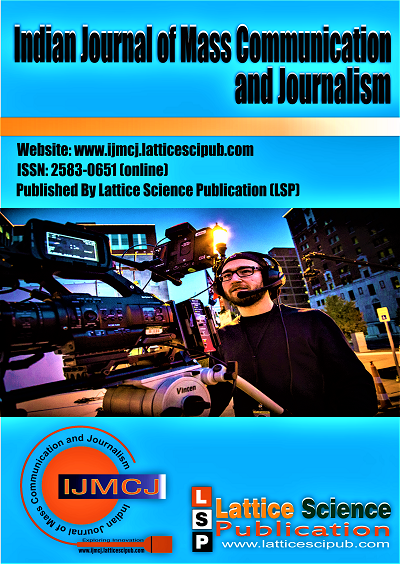Effectiveness of ‘Instagram’ on the Patronage of Commercial Organizations
Main Article Content
Abstract
Instagram, a popular social media platform with over a billion active users, has become a powerful tool for commercial organizations. Its visual-centric format, engagement features, and advertising capabilities provide businesses with unique opportunities to attract and retain customers. This analysis explores the effectiveness of Instagram in driving patronage for commercial organizations. Instagram has proven to be an effective platform for driving patronage for commercial organizations. Its visual-centric approach, robust engagement tools, and targeted advertising capabilities enable businesses to increase brand awareness, engage customers, and drive sales. However, success on Instagram requires a strategic approach, continuous effort, and adaptability to platform changes and audience preferences. By leveraging Instagram’s unique features and maintaining authenticity, businesses can significantly enhance their patronage and overall success. This study employed Uses and Gratification Theory and the survey method was used in the study. The population of this study consists of students of Caleb University. As such, the total number of students in Caleb University is 3000. The sample size selected for this study is Six hundred (600) and purposive sampling technique was adopted to select Six hundred (600) sample size. The findings of the study show students use Instagram for several purposes. It was also observed that the students assess the Instagram network in various ways and with different gadgets. The study concludes that the students pay a moderate level of attention to Instagram asthisindicated that there was less addiction level by the students to the platform.
Downloads
Article Details

This work is licensed under a Creative Commons Attribution-NonCommercial-NoDerivatives 4.0 International License.
How to Cite
References
Ahmed, M. O., & Msughter, A. E. (2022). Assessment of the spread of fake news of Covid-19 amongst social media users in Kano State, Nigeria. Computers in Human Behavior Reports, 6, 100189. DOI: https://doi.org/10.1016/j.chbr.2022.100189
Aondover, E. M. (2020). Internet meme as a campaign tool to the fight against Covid-19 in Nigeria. Global Journal of Human-Social Science: A Arts & Humanities – Psychology, 20(6), pp. 27-39. https://globaljournals.org/GJHSS_Volume20/4-Internet-Meme-as-a-Campaign.pdf
Aondover, E. M., Maradun, L. U., & Yar’Adua, S. M. (2022). Mediatization of the net and internetization of the print media in Northern Nigeria. Unisia, 40(2), 335-356. DOI: https://doi.org/10.20885/unisia.vol40.iss2.art5
Aondover, E. M., Oyeleye, S. A., & Aliyu, M. A. (2023). New World Information and Communication Order and its changing role in Nigerian Television Authority (NTA) Kano. Unisia, 41(1), 17-38. DOI: https://doi.org/10.20885/unisia.vol41.iss1.art2
Aondover, P. O., Aondover, E. M., & Babele, A. M. (2022). Two nations, same technology, different outcomes: Analysis of technology application in Africa and America. Journal of Educational Research and Review, 1(1), 001-008. https://www.researchgate.net/profile/Aondover-Eric-Msughter-2/publication/368242419_Two_Nations_Same_Technology_Different_Outcomes_Analysis_of_Technology_Application_in_Africa_and_America/links/64b28795c41fb852dd772bc7/Two-Nations-Same-Technology-Different-Outcomes-Analysis-of-Technology-Application-in-Africa-and-America.pdf
Boateng, R., & Amankwaa, A. (2016). The impact of social media on student academic life in higher education. Global Journal of Human-Social Science, 16(4), 1-8. https://globaljournals.org/GJHSS_Volume16/1-The-Impact-of-Social.pdf
Elham, A., & van Tooren, M. J. (2014). Winglet multi-objective shape optimization. Aerospace Science and Technology, 37, 93-109. DOI: https://doi.org/10.1016/j.ast.2014.05.011
Hile, M. M., Msughter, A. E., & Aliyu, M. A. (2023). Secularism and Ethical Issues in Media Practice as a Bane for National Development. SIASAT, 8(3), 166-177. DOI: https://doi.org/10.33258/siasat.v8i3.159
Idris, M. K., & Msughter, A. E. (2022). Sources of Information on National Issues among Border Communities in Yobe State, Nigeria. ASEAN Journal of Community Engagement, 6(1), 22-47. DOI: https://doi.org/10.7454/ajce.v6i1.1169
Kurfi, M. Y, Aondover, E. M. & Mohammed. I. (2021a). Digital Images on Social Media and Proliferation of Fake News on Covid-19 in Kano, Nigeria. Galactica Media: Journal of Media Studies, 1(1), 103-124. DOI: https://doi.org/10.46539/gmd.v3i1.111
Maikaba, B., & Msughter, A. E. (2019). Digital Media and Cultural Globalisation: The Fate of African Value System. Humanities and Social Sciences, 12(1), 214-220. DOI: https://doi.org/10.11648/j.hss.20190706.15
Maradun, L. U., Yar’Adua, S. M., & Msughter, A. E. (2021). Perceived value of social media in the# EndSARS’protest in Nigeria. International Journal of English Literature and Culture, 9(3), 69-80. https://www.researchgate.net/publication/356537604_Perceived_Value_of_Social_Media_in_the_EndSARS'_Protest_in_Nigeria
Mojaye, E. M. & Aondover, E. M. (2022). Theoretical perspectives in world information systems: A propositional appraisal of new media-communication imperatives. Journal of Communication and Media Research, 14(1), 100-106. DOI: https://doi.org/10.1515/omgc-2022-0048
Raut, V., & Patil, P. (2016). Use of Social Media in Education: Positive and Negative impact on the students. International Journal on Recent and Innovation Trends in Computing and Communication, 4(1), 281-285. https://ijritcc.org/download/conferences/ICRRTET_2016/ICRRTET_Track/1455261816_12-02-2016.pdf
Tarek, H. & Hashem, R. (2015). Treatment Outcome In Patients With Metastatic Head & Neck Cancer (Doctoral dissertation, Cairo University). http://195.246.42.221/index.php/cutheses/article/view/4657
Nirmala B, SP. Chokkalingam, G. Sai Neelima, Abnormal User Detection of Malicious Accounts in Online Social Networks using Cookie Based Cross Verification. (2019). In International Journal of Innovative Technology and Exploring Engineering (Vol. 8, Issue 9S4, pp. 202–205). DOI: https://doi.org/10.35940/ijitee.i1131.0789s419
Khadeeja Bilquees A., Deepa Ittimani Tholath, The Influence of Instagram Travel Influencers and Travel Motivation on Destination Image and Travel Intention. (2019). In International Journal of Recent Technology and Engineering (Vol. 8, Issue 4S3, pp. 253–255). DOI: https://doi.org/10.35940/ijrte.d1049.1284s319
Uparkar, S. S., Asati, K. R., Sahahare, P. U., & Vaidya, N. V. (2019). Data Analytics of Social Networking sites using Game Theory Model. In International Journal of Engineering and Advanced Technology (Vol. 8, Issue 6s3, pp. 1046–1050). DOI: https://doi.org/10.35940/ijeat.f1332.0986s319
Srivastava, A., & Saxena, Dr. U. K. (2023). Digital Media and Media literacy. An Analysis of the Contribution and Effect of social media in Media Literacy. In Indian Journal of Mass Communication and Journalism (Vol. 3, Issue 1, pp. 17–22). DOI: https://doi.org/10.54105/ijmcj.a1051.093123





